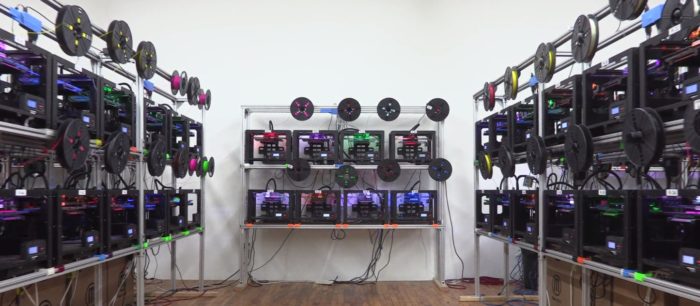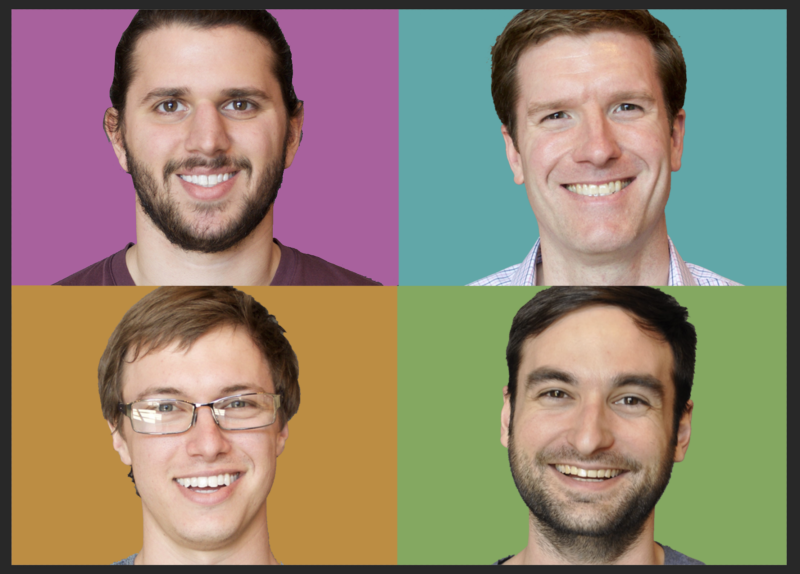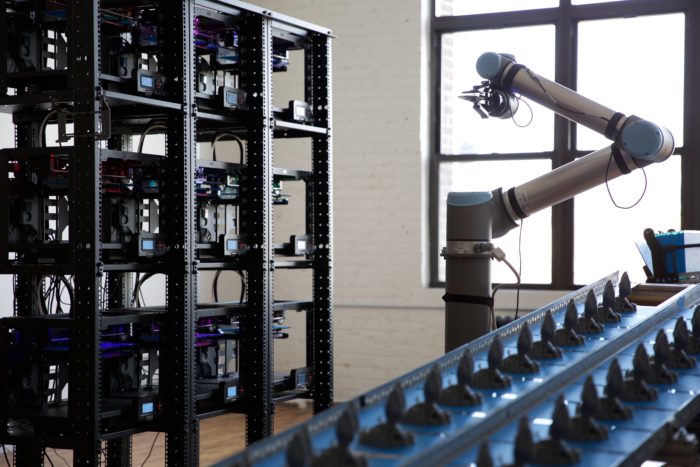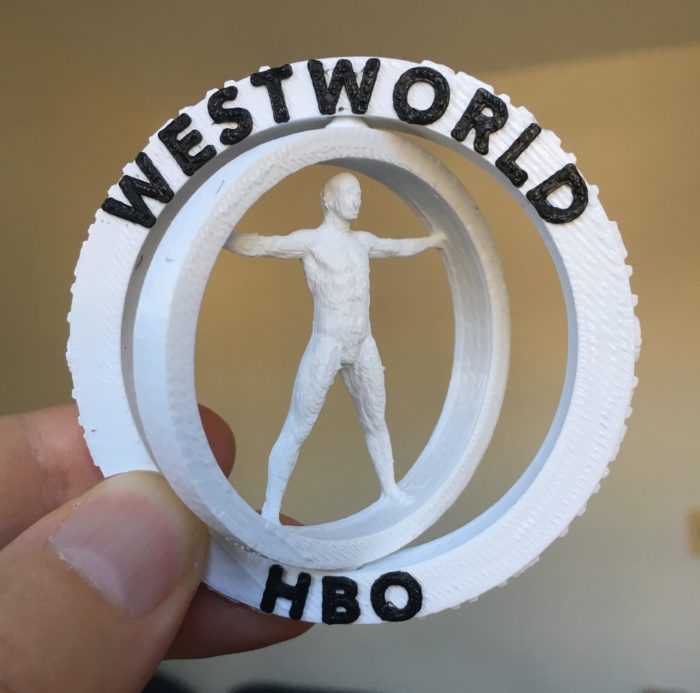Throughout a sizable corner space at 361 Stagg St. in East Williamsburg–a refurbished industrial building so close to Newtown Creek that its tenants could organize a rock-skipping contest from the roof–Voodoo Manufacturing has organized more than 200 desktop 3D printers into head-high stacks. Buzzing tirelessly, the machines magically–hence the company name–turn colorful plastic filament into finished products.
Founded in 2015, the company produces everything from machine parts to cheeky tchotchkes to toys, dolls, and more. The secret to their quick success, which has brought them more than 2,000 customers who’ve ordered in excess of 400,000 pieces, lies in the technology’s easy accessibility, lightning speed, and vivid manufacturing promises.
Standing between two walls of printers, the tall, bearded cofounder and chief product officer Jonathan Schwartz says he and his three partners, Max Friefeld, Patrick Deem and Oliver Ortlieb, had two key insights when they began Voodoo. “These machines, which everyone at the time thought were toys or for hobbyists or maybe engineers, could absolutely be used to make parts that people had to buy; you just needed to pair them with the right applications,” he says.

The stacked printers can operate individually or en masse for large product runs
Not only that, but they could do it in volume. “It was actually possible to build a factory that was efficient enough, with these machines, to produce thousands of parts that are cost competitive with traditional manufacturers.” Their foresight came, in part, because the four of them had built software for desktop printers before, namely at MakerBot, the groundbreaking 3-D printer manufacturer, founded in 2009 and based in Downtown Brooklyn.
“This is a digital factory,” says Schwartz, a Manhattan native now living in Williamsburg, of Voodoo’s space. “Most manufacturing has some fixed startup cost, whether it’s a mold you have to make or if you have to retool the machine to go from making part A to part B.” Companies with that traditional setup are incentivized to mass-produce their items, he says, and are comparatively handicapped in reacting to a shifting market.
Voodoo’s printers, connected to Wi-Fi and computer-programmed, are always ready for new instructions. They can each print a different product, or the exact same item in dancing unison.
While showing off a cookie cutter shaped like a lobster, Schwartz says of Voodoo’s products: “They don’t have the exact same surface finish as an injected-molded part.” Schwartz then points to the easy-to-miss layer lines, indicating that the piece is in fact comprised of many ropes of plastic fused together. “But we consider the quality to be pretty damn good.” Many products don’t require a flawlessly buffed surface—and the technology will only improve over time, he says.

The four partners, clockwise from upper left: Jonathan Schwartz, Patrick Deem, Oliver Ortleib, and Max Friefeld (Grid graphic by Heather Jones)
Companies can use Voodoo as both a manufacturer and fulfillment center, designing their products with Voodoo in tandem, before having the items shipped directly to buyers shortly after completion. “That’s like the Holy Grail from their perspective,” Schwartz says on behalf of his clients. “It’s seamless. They can be incredibly reactive to the market and to culture [and] there’s no real risk to launching new products.” He observes that a company can order a variety of items from Voodoo for test marketing to “see what sticks” and then “double down on those.”
“We really feel like this is the future of commerce and of manufacturing,” he says.
Schwartz met two of his three partners–Friefeld, Voodoo’s CEO; and Ortlieb, the company’s CTO–at Harvey Mudd College, an engineering school in Southern California. In 2012, while Schwartz and Friefeld were still enrolled and soon after Ortlieb had graduated, they thought up their first company, a 3D printing software outfit called Layer By Layer. Like the goal with Voodoo, Schwartz says, the mission of Layer By Layer was to “take this amazing technology and deliver it to the world in a valuable way.”
They raised some funding in 2013 by enrolling Layer By Layer in Y Combinator, a startup accelerator that brings company founders to Silicon Valley for three months while they work with the firm’s advisors on how to improve their company. Shortly thereafter, MakerBot bought Layer By Layer and integrated Schwartz, Friefeld, and Ortlieb into the staff. There, they befriended new colleague Patrick Deem, now Voodoo’s CFO. After about a year at MakerBot, the foursome decided to break off and form their own manufacturing company, starting with 80 3D printers bought from MakerBot.

The company is developing robotic arms to assist the movement of finished products
Since founding Voodoo, they’ve raised more than $6.5 million across three different funding rounds from angel investors and venture-capital heavyweights like Kleiner, Perkins, Caufield & Byers and General Catalyst. As with their earlier startup, Voodoo was welcomed into Y Combinator as well.
Voodoo’s visibility took another step up when HBO hired the company to do live 3D printing at premiere events for the new season of Westworld. “We designed and manufactured what we call gimbal coins,” Schwartz says. Enclosed in a ring, attached at the head and feet, is the recognizable white body of the AI-turned-sentient robots on the show. They can spin around inside the ring with the flick of a finger, and Schwartz says the attendees were intrigued with seeing the keepsake come to life on the printers.

The Westwood souvenir gyro, made live at premiere events (Photo by Michael Stahl)
As it happens, Voodoo is developing robots that can tend to the printers, keeping them running longer. The company has diversified its raw materials as well. Until May they’d been using polylactic acid–a versatile, corn-based and biodegradable plastic–to make their products. Seeking a stronger material with a greater resistance to the temperature spectrum, Voodoo switched to polyethylene terephthalate glycol (PET-G) and rigid thermoplastic polyurethane (TPU). (Schwartz says PET-G is not biodegradable, but is recyclable, falling in line with the company’s dedication to maintaining a minimized carbon footprint.)
“With the introduction of PET-G and Rigid TPU, Voodoo can expand to a wider market,” a company statement said, “reaching applications in robotics, aerospace, automotive, consumer electronics, and beyond.”
All this Voodoo innovation is going to continue to take place in Brooklyn, says Schwartz. “That wasn’t always ‘a thing,’ being a Brooklyn company,” he says. “I really value it; we all love being here. We love the sense of community we get from being in Brooklyn, the access to great talent, and all the amazing resources the city has to offer. We plan on being in Brooklyn as long as it makes sense.”
He does add, however, that Voodoo hopes to one day spread its magic, opening plants across the U.S. and possibly the world.
“Technology is worth nothing for its own sake,” Schwartz says. “Technology is about what it does for people. You could have the most amazing technology, but if it’s not made for accessibility, it’ll sit in a room and do nothing.”